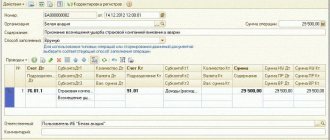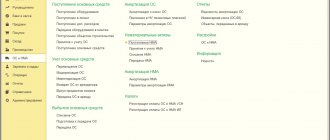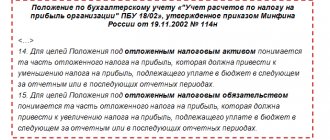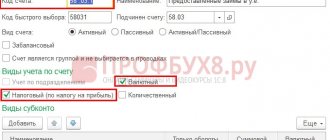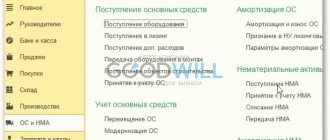Intangible assets or intangible assets are any values that belong to legal entities that do not have a physical form, but by their status have a price characteristic. Intangible assets are accounted for in entries on accounting account 04.
Intangible assets have the ability to be valued in monetary terms and also be used to generate profit from income. In addition, the value of intangible assets serves as an indicator of the reputation and evaluation of the enterprise's performance.
As a rule, an organization's intangible assets include all kinds of patents, technological developments, software, product licenses and other intellectual property. In addition, it should be taken into account that trademarks and privileges of any owner are also considered intangible assets.
When working with intangible assets, special attention should be paid to the characteristics by which they are allocated to their group, namely:
- Lack of physical component;
- Mandatory possibility of exploitation for the enterprise to obtain benefits in the future;
- The ability to separate from the rest of the organization’s property;
- Possibility of use for a long period of time (more than a year);
- Availability of documents that confirm the existence of this intangible asset;
- Lack of plans to resell assets;
The concept of intangible assets (IMA)
Intangible assets (IMA) are understood as monetary investments in intangible objects for the purpose of their further use and obtaining financial benefits.
| ★ Best-selling book “Accounting from scratch” for dummies (understand how to do accounting in 72 hours) > 8000 books purchased |
The main criteria for classifying property as intangible assets are:
- the object lacks a material structure;
- difference between the object and other types of property;
- use for production purposes;
- ability to bring economic benefit.
Also included in the category of intangible assets are the exclusive right to use computer programs, as well as the right to an invention and a trademark.
Inventory of account MC.04
For organizations, conducting an inventory is a mandatory procedure (clause 27 of the Regulations on accounting, approved by order of the Ministry of Finance of the Russian Federation dated July 29, 1998 No. 34n). In this case, both balance sheet and off-balance sheet accounts must be audited.
You will find a sample inventory list of inventory items accepted for safekeeping in ConsultantPlus. Trial access to the system can be obtained for free.
You can learn more about the inventory procedure for off-balance sheet accounts in this material.
Off-balance sheet accounting of inventory and other business property is carried out to monitor its safety. Because of this, an inventory of such property is a necessity, allowing one to identify the actual presence of property listed in the records. The 1C: Accounting program provides additional processing used in the document “Inventory of goods in warehouse”. It allows you to inventory assets in the off-balance sheet account MTs.04.
Account 04 in accounting. Accounting for transactions with intangible assets
To reflect generalized information about transactions with intangible assets (receipt, depreciation, liquidation, etc.), accounting account 04 is used.
An intangible asset accounted for on the balance sheet of an organization can be created on its own, or exclusive rights to it can be acquired from another enterprise.
In the case of purchasing intangible assets from a third party, payment transactions can be reflected in the following records:
| Debit | Credit | Description | Document |
| 04 | 50 | Payment for intangible assets was made in cash | Account cash warrant |
| 04 | 51 | Funds were transferred to pay for the intangible asset | Payment order |
| 04 | 52 | Payment of expenses for the acquisition of intangible assets in foreign currency was made | Currency order |
| 04 | 55 | Funds were debited from a special bank account to pay for intangible assets | Bank statement |
If an organization creates an intangible asset object on its own, then such operations are reflected by postings:
| Debit | Credit | Description | Document |
| 08 Creation of intangible assets | 60 (10, 68, 69, 70, 76…) | The costs of creating an intangible asset are included in investments in intangible assets | Salary statements, certificates of work performed, etc. |
| 04 | 08 Creation of intangible assets | The created object is reflected in the intangible assets | NMA-1 registration card |
Depreciation charges, which must be reflected monthly for intangible assets, are accumulated on account 05. The main operations for calculating depreciation on intangible assets are carried out as follows:
| Debit | Credit | Description | Document |
| 08 | 05 | Depreciation charges for intangible assets used to create a new intangible asset are taken into account | Depreciation statement |
| 44 | 05 | Depreciation charges for intangible assets used in retail trade are taken into account | Depreciation statement |
| 91.2 | 05 | Depreciation charges for an intangible asset used in the social sphere are taken into account | Depreciation statement |
| 20 | 05 | The amount of depreciation charges for an intangible asset used in the main production is taken into account | Depreciation statement |
| 23 | 05 | The amount of depreciation charges for an intangible asset used in auxiliary production is taken into account | Depreciation statement |
| 29 | 05 | The amount of depreciation charges for an intangible asset used in service production is taken into account | Depreciation statement |
When recording operations to liquidate intangible assets, the residual value of the object can be written off with the following entries:
| Debit | Credit | Description | Document |
| 58.4 | 04 | The residual value of intangible assets was written off (transferred as a contribution under a simple partnership agreement) | NMA-1 registration card |
| 91.2 | 04 | The residual value of intangible assets is written off (transferred free of charge) | NMA-1 registration card |
| 58.1 | 04 | The residual value of intangible assets is written off (transferred as a contribution to the authorized capital of another organization) | NMA-1 registration card |
Entries on the debit of account MTs.04
According to the Chart of Accounts (order of the Ministry of Finance of the Russian Federation dated October 31, 2000 No. 94n), the balance sheet account 10.09 is used to capitalize inventory and household supplies. To reflect this business operation in the 1C: Accounting program, the document “Receipt of goods and services” is provided.
When instruments and other inventory are accepted for accounting, a new document is created with the transaction type “Purchase, commission”. The document is filled out indicating:
- what has to happen
- from whom,
- in what quantity,
- at what price.
Account 10.09 “Inventory and household supplies” is selected as a debit accounting account.
An entry in the credit of account 10.09 occurs when inventory and other household property are transferred into operation. For this purpose, a document “Transfer of materials into operation” is created and carried out.
When transferring inventory, fill out the “Inventory and Household Supplies” tab:
- the nomenclature of transferred values is selected by position,
- the employee accepting them for use,
- the accounting account 10.09 and the method of reflecting costs are indicated.
When posting a document, values are written off from accounting account 10.09 to the cost account. At the same time, these values are debited to account MTs.04 in the context of nomenclature, quantity and financially responsible persons. In this way, proper control over the safety of the organization’s property can be organized.
The document “Transfer of materials into operation” allows you to print the issue record sheet (form MB-7) or the demand invoice (form M-11). If necessary, you can change the financially responsible person responsible for the safety of economic assets recorded on the balance sheet.
Account 04: examples of reflecting transactions
The main operations with intangible assets include their acquisition, creation and write-off. Let's look at each of these operations using an example.
Account 04. Purchase of intangible assets
Flagman LLC acquired from Egida LLC the exclusive right to an invention that allows optimizing the production process. According to the patent assignment agreement, the cost of the right to the invention was 67,500 rubles. When registering with Rospatent, Flagman LLC paid a state fee in the amount of 3,800 rubles.
The following entries were made in the accounting of Flagman LLC:
| Debit | Credit | Description | Sum | Document |
| 60 | 51 | Flagman LLC transferred funds to Egida LLC in payment for the patent | 67,500 rub. | Payment order |
| 08 | 60 | The cost of the patent is reflected as part of investments in intangible assets | 67,500 rub. | Agreement |
| 08 | 60 | The cost of the state duty is reflected as part of investments in intangible assets | RUB 3,800 | Receipt for payment of state duty |
| 04 | 08 | Intangible assets accepted for accounting (RUB 67,500 + RUB 3,800) | 71,300 rub. | NMA-1 registration card |
Read about the accounting accounts used in accounting in the articles: account 60 (accounting for settlements with suppliers and contractors), account 08 (investments in non-current assets).
Account 04. Creation of intangible assets on your own
Monolit LLC created its own trademark, recognized as an intangible asset. The process of developing the sign took 1 month, during which the employees of Monolit LLC were paid salaries and accrued insurance contributions:
- salary – 67,000 rubles;
- mandatory insurance premiums – 20,100 rubles. (RUB 67,000 * (22% + 2.9% + 5.1%));
- insurance against accidents and occupational diseases – 134 rubles. (RUB 67,000 * 0.2%).
Upon completion of the development process, Monolit LLC received a certificate of exclusive right to the mark, having paid a state fee of 28,800 rubles.
The following entries were reflected in the accounting of Monolit LLC:
| Debit | Credit | Description | Sum | Document |
| 08 Creation of intangible assets | 70, 69 | The expenses for paying salaries (and insurance premiums) to development employees are reflected (RUB 67,000 + RUB 20,100 + RUB 134) | RUB 87,234 | Payroll sheet |
| 76 | 51 | Payment of the state duty amount | RUB 28,800 | Payment order |
| 08 Creation of intangible assets | 76 | The cost of the state duty is reflected as part of investments in intangible assets | RUB 28,800 | Certificate for a trademark |
| 04 | 08 Creation of intangible assets | The trademark is included in the intangible assets (RUB 87,243 + RUB 28,800) | RUB 116,043 | NMA-1 registration card |
Read about the accounting accounts used in accounting in the articles: account 70 (payroll accounting), account 69 (social insurance calculations), account 76, account 51 (current account).
Account 04. Write-off of intangible assets
Globus LLC owns the exclusive right to a technical invention. This invention is registered as an intangible asset. As of 02/01/2016:
- initial cost of intangible assets – 132,000 rubles;
- the amount of accrued depreciation (account 05) is 43,500 rubles.
According to the agreement, Globus LLC will exercise the exclusive right to the invention of Breeze LLC at a price of 118,300 rubles.
Operations to write off intangible assets in connection with the sale were reflected in the accounting of Globus LLC with the following entries:
| Debit | Credit | Description | Sum | Document |
| 76 | 91.1 | The amount of income from the sale of intangible assets is taken into account | RUB 118,300 | Patent assignment agreement |
| 05 | 04 | The amount of depreciation accrued on the sold intangible asset was written off | RUB 43,500 | Patent assignment agreement, registration card NMA-1 |
| 91.2 | 04 | The residual value of the sold intangible assets is written off | RUB 88,500 | Patent assignment agreement, registration card NMA-1 |
| 51 | 76 | Funds have been credited from Breeze LLC as payment for the right to the invention | RUB 118,300 | Bank statement |
| 91.9 | 99 | The amount of the financial result is taken into account (RUB 118,300 – RUB 88,500) | RUB 29,800 | Turnover balance sheet |
Read about the accounting accounts used in accounting in the articles: account 91.1 and 91.2 (exchange differences), account 99 (accounting for financial results).
Why are off-balance sheet accounts of MC needed (MC.01, MC.02, MC.03, MC.04)
In the chart of accounts of the 1C: Accounting program there is a number of additional off-balance sheet accounts in addition to the 11 generally accepted ones.
This is done for more thorough and convenient accounting. Account MC.04 is a subaccount of the MC account “Material assets in operation” along with three more subaccounts:
- MC.01 “Fixed assets in operation”,
- MC.02 “Workwear in operation”,
- MTs.03 “Special equipment in operation.”
МЦ.02—an off-balance sheet account used to account for special clothing issued to an employee to perform his official duties. Account MTs.03 accumulates information on special tools and equipment transferred into operation. Account MTs.01 is often used if the fixed asset is reflected differently in tax and accounting.
The introduction of these accounts into accounting is due to the need to control property written off from the organization’s balance sheet, included in costs, but used in the organization’s economic activities. Their debit reflects the values to be accounted for, broken down by item items, financially responsible persons and storage locations. The loan reflects the write-off of assets. In this case, transactions are recorded only in debit or only in credit of such accounts - correspondence is not typical for off-balance sheet accounts.
Find out what and how to take into account on off-balance sheet accounts in ConsultantPlus. Learn the material by getting trial access to the system for free.
You can get acquainted with the features of using off-balance sheet accounts in accounting in the article “Rules for maintaining accounting records on off-balance sheet accounts”.
Documents confirming the creation/purchase of intangible assets
The basis for recording entries for transactions with intangible assets are primary documents. Account entries in the Intangible MA-1 card and postings to account 04 are carried out only if there are correctly executed supporting documents. Documents that confirm the acquisition of intangible assets can be presented in the table below.
Read more: Intangible assets. Formula. Calculation
| Type of intangible asset | Confirmation document |
| Industrial invention | Patent (issued by the Federal Service for Intellectual Property) |
| Computer or database (database), audio and video recordings | Certificate of registration of the right to create this asset in the organization, documents confirming the purchase of intangible assets |
| Topology of integrated circuits | Certificate of registration of the right to create this asset in the organization, documents confirming the purchase of intangible assets |
| Trademark, name | Certificate of registration of rights issued by Rospatent |
| Business reputation | Purchase and sale agreement for the organization as a whole with registration in Rosreestr |
Results
The off-balance sheet account MTs.04 is used by users of the accounting program “1C: Accounting” to account for the inventory and household supplies transferred into operation. Inventory receipts are debited from this account, and disposals are credited to this account. Analytics is carried out in quantitative terms, by item items and financially responsible persons.
Sources:
- Order of the Ministry of Finance of the Russian Federation dated October 31, 2000 N 94n
- Order of the Ministry of Finance of Russia dated July 29, 1998 N 34n
You can find more complete information on the topic in ConsultantPlus. Free trial access to the system for 2 days.
Examples of accounting entries for analyzing changes in the balance sheet under the influence of business transactions
Let's look at examples of basic accounting entries using the example of Alliance LLC.
Example 2
In June Gordienko A.V. decided to create a company for the production of custom-made furniture. He had his own savings of 100,000 rubles. and a machine worth 55,000 rubles. This property was contributed by him as a contribution to the authorized capital.
The very first entry in any company is the reflection of the authorized capital. Selecting the corresponding accounts:
- 75 “Settlements with founders”;
- 80 “Authorized capital”.
According to the constituent documents, Gordienko A.V. must contribute 155,000 rubles to Alliance LLC. We record this fact by writing: Dt 75 Kt 80 - 155,000 rubles.
Of these, 100,000 rubles. were deposited into a bank account. Current accounts are account 51. We send funds from Gordienko A.V. to the company's account with the following posting: Dt 51 Kt 75 - 100,000 rubles.
According to sub. 5 clause 1 PBU 6/01 property worth no more than 40,000 rubles. can be taken into account as part of inventories (inventories). If an asset is valued at a higher cost, it is classified as depreciable property. Thus, we record the receipt of fixed assets as a contribution to the management company with the entry: Dt 08 Kt 75 - 55,000 rubles.
If a company applies PBU 18/02, it is obliged to reflect temporary differences between accounting and tax accounting (BU and NU), since in tax accounting assets with a cost of 100,000 rubles are included in fixed assets. and more. What transactions should be used to display temporary differences between accounting and financial accounting and what changes in PBU 18/02 apply from 2021? The answers to these and other questions are in the ConsultantPlus ready-made solution; get trial access to the system for free.
We put the OS object into operation by wiring: Dt 01 Kt 08 - 55,000 rubles.
At the end of the month, it will be necessary to calculate depreciation according to the method prescribed in the accounting policy. Since the machine is directly involved in production, we select account 20 to account for depreciation costs.
According to the accounting policy, the company uses the straight-line method of calculating depreciation. The useful life of the machine is 60 months (55,000 rubles divided by 60 months and we get 900 rubles of depreciation per month).
For examples of calculating depreciation using the FIFO and LIFO methods, see the article “Example of calculation using the FIFO and LIFO methods in accounting.”
This fact is reflected by the entry: Dt 20 Kt 02 - 900 rub.
Cash in the amount of 70,000 rubles. were used to purchase materials.
Let's make the wiring:
- Dt 60 Kt 51 - 70,000 rub. (materials paid to the supplier, primary document - bank statement);
- Dt 10 Kt 60 - 59,300 rub. (materials received, primary material - TORG-12, invoice);
- Dt 19 Kt 60 - 10,700 rub. (input VAT included).
The company submitted input VAT for deduction, reflecting it in the purchase book and recording it with the following posting: Dt 68 (VAT subaccount) Kt 19 - 10,700 rubles.
During the month, the company produced 2 orders:
- wardrobe with a cost of 25,000 rubles. (including materials for 15,000 rubles and payroll 10,000 rubles, including contributions);
- kitchen set costing 45,000 rubles. (including materials for 35,000 rubles and payroll 10,000 rubles, including contributions).
Thus, materials in the amount of 50,000 rubles. (15,000 + 35,000) were written off for production.
| Dt | CT | Amount, rub. | Content | Document |
| 20 | 10 | 15 000 | Materials transferred for cabinet production | Request-invoice |
| 20 | 10 | 35 000 | Materials transferred for the production of kitchen sets | |
| 20 | 70 | 15 400 | Salary accrued | Payslip |
| 20 | 69 | 4 600 | Payroll contributions accrued | |
| 43 | 20 | 25 000 | The finished cabinet is transferred to the warehouse | Production report |
| 43 | 20 | 45 000 | The finished kitchen set has been delivered to the warehouse |
The cabinet was sold for 42,000 rubles, and the kitchen set for 70,000 rubles. Payment for the cabinet was received in the amount of 20,000 rubles. The balance is 22,000 rubles. The buyer, according to the agreement, will transfer until July 10. Payment for the kitchen has been received in full.
| Dt | CT | Amount, rub. | Content | Document |
| 51 | 62 | 10 000 | Payment has been received for the wardrobe | Bank statement |
| 62 | 90 | 42 000 | Wardrobe sold | TORG-12, invoice |
| 90 | 43 | 25 000 | The cost of the cabinet has been written off | |
| 90 | 68 | 6 400 | VAT charged | |
| 51 | 62 | 70 000 | Received payment for kitchen | Extract |
| 62 | 90 | 70 000 | Kitchen sold | TORG-12, invoice |
| 90 | 68 | 10 700 | VAT charged | |
| 90 | 43 | 45 000 | The cost of the kitchen has been written off |
On June 15, the bank received DS in the amount of 15,000 rubles: Dt 50 Kt 51 - 15,000 rubles.
Of this, an advance was paid to employees in the amount of 12,000 rubles: Dt 70 Kt 50 - 12,000 rubles.
An accountant works at Alliance LLC. On June 30, he received a salary of 5,000 rubles, and contributions from the payroll amounted to 1,500 rubles:
- Dt 26 Kt 70 - 5,000 rub.;
- Dt 26 Kt 69 — 1,500 rub.
On the same day, contributions were transferred from the salaries of all employees: Dt 69 Kt 51 - 6,100 rubles. (4,600 + 1,500).
Since the employer is a tax agent, he is obliged to withhold and transfer personal income tax from the income of employees. For residents it is 13%. That is, for June, Alliance LLC needs to transfer 2,600 rubles to the budget. (20,400 × 13%).
These operations are recorded by postings:
- Dt 70 Kt 68 (personal income tax subaccount) - tax accrued;
- Dt 68 Kt 51 - tax transfer.
On the last day of the month, it is necessary to close cost accounts to identify financial results. During the month, all general production and general business expenses are collected in Dt account 25 (26).
At the end of the month, the balance is distributed among the products produced and is recorded as follows: Dt 20 Kt 26 - 6,500 rubles.
The balance of account 20 is closed to the debit of account 90 in the absence of work in progress: Dt 90.2 Kt 20 - 7,400 rubles.
To compile a summary SALT, and then prepare to submit the balance, let’s consider the turnover for each account involved.
| Decoding | 01 | |||
| Turnover | Balance | |||
| Dt | CT | Dt | CT | |
| OS put into operation | 55 000 | 55 000 | ||
| Turnover | 55 000 | 0 | 55 000 | 0 |
| Decoding | 02 | |||
| Turnover | Balance | |||
| Dt | CT | Dt | CT | |
| Depreciation accrued | 900 | 900 | ||
| Turnover | 0 | 900 | 0 | 900 |
| Decoding | 08 | |||
| Turnover | Balance | |||
| Dt | CT | Dt | CT | |
| Introduced the Criminal Code in the form of an OS object | 55 000 | |||
| OS put into operation | 55 000 | |||
| Turnover | 55 000 | 55 000 | 0 | 0 |
| Decoding | 10 | |||
| Turnover | Balance | |||
| Dt | CT | Dt | CT | |
| Materials received | 59 300 | |||
| Materials written off for cabinet production | 15 000 | |||
| Materials written off for kitchen production | 35 000 | |||
| Turnover | 59 300 | 50 000 | 9 300 | 0 |
| Decoding | 19 | |||
| Turnover | Balance | |||
| Dt | CT | Dt | CT | |
| Input VAT received from the supplier | 10 700 | |||
| VAT is deductible | 10 700 | |||
| Turnover | 10 700 | 10 700 | 0 | 0 |
| Decoding | 20 | |||
| Turnover | Balance | |||
| Dt | CT | Dt | CT | |
| Depreciation accrued | 900 | |||
| Cost of materials for cabinet production | 15 000 | |||
| Cost of materials for making a kitchen | 35 000 | |||
| Assembly wages | 15 400 | |||
| Contributions from payroll | 4 600 | |||
| Ready-made cabinet released | 25 000 | |||
| Ready-made kitchen produced | 45 000 | |||
| Closing account 26 | 6 500 | |||
| Closing of the month (Dt 90.2 Kt 20) | 7 400 | |||
| Turnover | 77 400 | 77 400 | ||
| Decoding | 26 | |||
| Turnover | Balance | |||
| Dt | CT | Dt | CT | |
| Accountant's salary paid | 5 000 | |||
| The salary amount is distributed to the main production | 5 000 | |||
| Contributions from an accountant's salary | 1 500 | |||
| The amount of contributions is distributed to the main production | 1 500 | |||
| Turnover | 6 500 | 6 500 | ||
| Decoding | 43 | |||
| Turnover | Balance | |||
| Dt | CT | Dt | CT | |
| Closet | 25 000 | 25 000 | ||
| Kitchen | 45 000 | 45 000 | ||
| Turnover | 70 000 | 70 000 | ||
| Decoding | 50 | |||
| Turnover | Balance | |||
| Dt | CT | Dt | CT | |
| Received DS from the bank | 15 000 | |||
| Salary payment | 12 000 | |||
| Turnover | 15 000 | 12 000 | 3 000 | |
| Decoding | 51 | |||
| Turnover | Balance | |||
| Dt | CT | Dt | CT | |
| Contribution to the management company | 100 000 | |||
| Payment to the supplier for materials | 70 000 | |||
| Receipt of advance payment for the cabinet from the buyer | 20 000 | |||
| Receipt of DS from the buyer for the kitchen | 70 000 | |||
| DS transferred to the cashier | 15 000 | |||
| Contributions from payroll have been transferred | 6 100 | |||
| VAT payment | 6 400 | |||
| Personal income tax payment | 2 600 | |||
| Turnover | 190 000 | 100 100 | 89 900 | 0 |
| Decoding | 60 | |||
| Turnover | Balance | |||
| Dt | CT | Dt | CT | |
| Payment for materials | 70 000 | |||
| Receipt of materials | 59 300 | |||
| Input VAT taken into account | 10 700 | |||
| Turnover | 70 000 | 70 000 | ||
| Decoding | 62 | |||
| Turnover | Balance | |||
| Dt | CT | Dt | CT | |
| Received DS for the closet | 20 000 | |||
| Realization of the cabinet | 42 000 | |||
| Received DS for the kitchen | 70 000 | |||
| Implementation of kitchen | 70 000 | |||
| Turnover | 112 000 | 90 000 | 22 000 | |
| Decoding | 68 | |||
| Turnover | Balance | |||
| Dt | CT | Dt | CT | |
| Personal income tax | 2 600 | 2 600 | ||
| Personal income tax withheld | 2 600 | |||
| Personal income tax paid | 2 600 | |||
| VAT | 17 100 | 17 100 | ||
| VAT charged | 17 100 | |||
| Input VAT credited | 10 700 | |||
| VAT paid | 6 400 | |||
| Turnover | 19 700 | 19 700 | ||
| Decoding | 69 | |||
| Turnover | Balance | |||
| Dt | CT | Dt | CT | |
| Contributions from the payroll of collectors | 4 600 | |||
| Contributions from the accountant's payroll | 1 500 | |||
| Payment | 6 100 | |||
| Turnover | 6 100 | 6 100 | ||
| Decoding | 70 | |||
| Turnover | Balance | |||
| Dt | CT | Dt | CT | |
| Collector salary | 15 400 | |||
| Accountant salary | 5 000 | |||
| Salary payment | 12 000 | |||
| Personal income tax | 2 600 | |||
| Turnover | 14 600 | 20 400 | 5 800 | |
| Decoding | 75 | |||
| Turnover | Balance | |||
| Dt | CT | Dt | CT | |
| AC accrued | 155 000 | |||
| DS deposited into the bank | 100 000 | |||
| The machine was contributed as a contribution to the management company | 55 000 | |||
| Turnover | 155 000 | 155 000 | ||
| Decoding | 80 | |||
| Turnover | Balance | |||
| Dt | CT | Dt | CT | |
| AC accrued | 155 000 | 155 000 | ||
| Turnover | 155 000 | 155 000 | ||
| Decoding | 90 | |||
| Turnover | Balance | |||
| Dt | CT | Dt | CT | |
| Realization of the cabinet | 42 000 | |||
| VAT charged | 6 400 | |||
| Cabinet cost | 25 000 | |||
| Implementation of kitchen | 70 000 | |||
| VAT charged | 10 700 | |||
| Kitchen cost | 45 000 | |||
| Closing account 20 | 7 400 | |||
| Closing the month | 17 500 | |||
| Turnover | 112 000 | 112 000 | ||
| Decoding | 99 | |||
| Turnover | Balance | |||
| Dt | CT | Dt | CT | |
| Financial result | 17 500 | |||
| Turnover | 17 500 | 17 500 | ||
Thus, in June Alliance LLC earned 17,500 rubles.
Consolidated SALT for June Alliance LLC
| Check | Account name | Revolutions | Balance | ||
| Dt | CT | Dt | CT | ||
| 01 | Fixed assets | 55 000 | 55 000 | ||
| 02 | Depreciation of fixed assets | 900 | 900 | ||
| 08 | Investments in non-current assets | 55 000 | 55 000 | ||
| 10 | Materials | 59 300 | 50 000 | 9 300 | |
| 19 | VAT on purchased assets | 10 700 | 10 700 | ||
| 20 | Primary production | 77 400 | 77 400 | ||
| 26 | General running costs | 6 500 | 6 500 | ||
| 43 | Finished products | 70 000 | 70 000 | ||
| 50 | Cash register | 15 000 | 12 000 | 3 000 | |
| 51 | Current accounts | 190 000 | 100 100 | 89 900 | |
| 60 | Settlements with suppliers | 70 000 | 70 000 | ||
| 62 | Settlements with customers | 112 000 | 90 000 | 22 000 | |
| 68 | Calculations for taxes and fees | 19 700 | 19 700 | ||
| 69 | Social insurance calculations | 6 100 | 6 100 | ||
| 70 | Payments to personnel regarding wages | 14 600 | 20 400 | 5 800 | |
| 75 | Settlements with founders | 155 000 | 155 000 | ||
| 80 | Authorized capital | 155 000 | 155 000 | ||
| 90 | Sales | 112 000 | 112 000 | ||
| 90.1 | Revenue | 112 000 | 95 000 | ||
| 90.2 | Cost of sales | 77 400 | 77 400 | ||
| 90.3 | VAT | 17 100 | 17 100 | ||
| 90.9 | Profit/loss from sales | 17 500 | 17 500 | ||
| 99 | Profit and loss | 17 500 | 17 500 | ||
| Turnover | 1 028 300 | 1 028 300 | 179 200 | 179 200 | |
The article “Accounting and analysis of financial results” will help to analyze the company’s performance in more detail and determine the impact of business transactions on the balance sheet.

